Related Research Articles

Ants are eusocial insects of the family Formicidae and, along with the related wasps and bees, belong to the order Hymenoptera. Ants appear in the fossil record across the globe in considerable diversity during the latest Early Cretaceous and early Late Cretaceous, suggesting an earlier origin. Ants evolved from vespoid wasp ancestors in the Cretaceous period, and diversified after the rise of flowering plants. More than 13,800 of an estimated total of 22,000 species have been classified. They are easily identified by their geniculate (elbowed) antennae and the distinctive node-like structure that forms their slender waists.
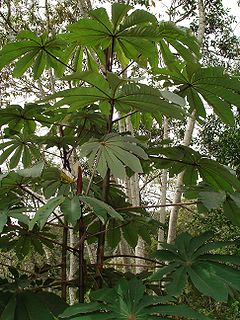
Cecropia is a Neotropical genus consisting of 61 recognized species with a highly distinctive lineage of dioecious trees. The genus consists of pioneer trees in the more or less humid parts of the Neotropics, with the majority of the species being myrmecophytic. Berg and Rosselli state that the genus is characterized by some unusual traits: spathes fully enclosing the flower-bearing parts of the inflorescences until anthesis, patches of dense indumentums (trichilia) producing Mullerian (food) at the base of the petiole, and anthers becoming detached at anthesis. Cecropia is most studied for its ecological role and association with ants. Its classification is controversial; in the past, it has been placed in the Cecropiaceae, Moraceae, or Urticaceae. The modern Angiosperm Phylogeny Group system places the "cecropiacean" group in the Urticaceae.
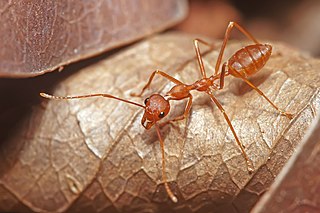
Weaver ants or green ants are eusocial insects of the family Formicidae. Weaver ants live in trees and are known for their unique nest building behaviour where workers construct nests by weaving together leaves using larval silk. Colonies can be extremely large consisting of more than a hundred nests spanning numerous trees and containing more than half a million workers. Like many other ant species, weaver ants prey on small insects and supplement their diet with carbohydrate-rich honeydew excreted by small insects (Hemiptera). Weaver ant workers exhibit a clear bimodal size distribution, with almost no overlap between the size of the minor and major workers. The major workers are approximately 8–10 mm (0.31–0.39 in) in length and the minors approximately half the length of the majors. Major workers forage, defend, maintain, and expand the colony whereas minor workers tend to stay within the nests where they care for the brood and 'milk' scale insects in or close to the nests.
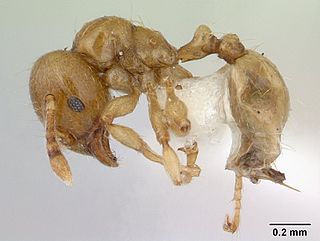
Allomerus decemarticulatus is an Amazonian ant species found in the tropics of South America. This species is most notable for the workers’ complex and extreme predatory behavior, which involves a symbiosis with both a plant and fungal species. They live in leaf pockets of a host plant species, Hirtella physophora. These leaf pockets are areas inside of the plant between the leaves and the stem. Each colony, which consists of about 1,200 workers, inhabits a single tree; however, the ants are spread among the leaf pockets, with typically 40 workers per pocket. Their diet primarily consists of large insects that are captured on the plant, but they also eat some kinds of food bodies produced by the plant as well as its nectar. They are able to capture their prey, which is much larger than themselves, by constructing a platform that acts as a trap for the unsuspecting prey. The ants hide in the trap and attack when any insect lands on it. This technique is an example of ambush predation.

Myrmecophily is the term applied to positive interspecies associations between ants and a variety of other organisms, such as plants, other arthropods, and fungi. Myrmecophily refers to mutualistic associations with ants, though in its more general use, the term may also refer to commensal or even parasitic interactions.

Odontomachus bauri is a species of ponerinae ant known as trap jaw ants. The trap jaw consists of mandibles which contain a spring-loaded catch mechanism.

Iridomyrmex, or the rainbow ant is a genus of ant first described by Austrian entomologist Gustav Mayr in 1862. He placed it in the subfamily Dolichoderinae of the family Formicidae. There are 79 described species and five fossil species. Most of these ants are native to Australia; others are found in Asia and Oceania, and they have been introduced to Brazil, New Zealand and the United Arab Emirates. Fossil species are known from China, France and the United States.

Trophobiosis is a symbiotic association between organisms where food is obtained or provided. The provider of food in the association is referred to as a trophobiont. The name is derived from the Greek τροφή trophē, meaning "nourishment" and -βίωσις -biosis which is short for the English symbiosis.

Cephalotes atratus is a species of arboreal ant in the genus Cephalotes, a genus characterized by its odd shaped head. These ants are known as gliding ants because of their ability to "parachute" by steering their fall if they lose their footing.
Insects have a wide variety of predators, including birds, reptiles, amphibians, mammals, carnivorous plants, and other arthropods. The great majority (80–99.99%) of individuals born do not survive to reproductive age, with perhaps 50% of this mortality rate attributed to predation. In order to deal with this ongoing escapist battle, insects have evolved a wide range of defense mechanisms. The only restraint on these adaptations is that their cost, in terms of time and energy, does not exceed the benefit that they provide to the organism. The further that a feature tips the balance towards beneficial, the more likely that selection will act upon the trait, passing it down to further generations. The opposite also holds true; defenses that are too costly will have a little chance of being passed down. Examples of defenses that have withstood the test of time include hiding, escape by flight or running, and firmly holding ground to fight as well as producing chemicals and social structures that help prevent predation.
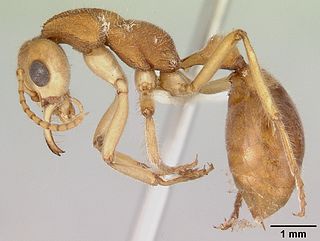
Prionomyrmecini is an ant tribe belonging to the subfamily Myrmeciinae established by William Morton Wheeler in 1915. Two members are a part of this tribe, the extant Nothomyrmecia and the extinct Prionomyrmex. The tribe was once considered a subfamily due to the similarities between Nothomyrmecia and Prionomyrmex, but such reclassification was not widely accepted by the scientific community. These ants can be identified by their long slender bodies, powerful stingers and elongated mandibles. Fossil Prionomyrmecini ants were once found throughout Europe, possibly nesting in trees and preferring jungle habitats. Today, Prionomyrmecini is only found in Australia, preferring old-growth mallee woodland surrounded by Eucalyptus trees. Nothomyrmecia workers feed on nectar and arthropods, using their compound eyes for prey and navigational purposes. Owing to their primitive nature, they do not recruit others to food sources or create pheromone trails. Nothomyrmecia colonies are small, consisting of 50 to 100 individuals.
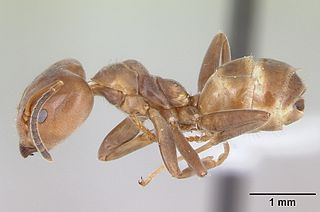
Azteca is a strictly Neotropical genus of ants in the subfamily Dolichoderinae. The genus is very diverse and contains around 84 extant species and two fossil species. They are essentially arboreal and many species have mutualistic associations with particular plant species, where the genus Cecropia presents the most conspicuous association. In the Brazilian Amazonia, Azteca species are associated with species of Codonanthopsis.

Ochetellus is a genus of ants first described by Steve Shattuck in 1992. He placed it in the subfamily Dolichoderinae of the family Formicidae. The ants in this genus are small and black in colour; workers measure 1.75 to 3 millimetres in length, the males at around 1.6 millimetres (0.06 in) are smaller, and the queens are the largest, reaching 4 millimetres (0.16 in). There are seven described species and three described subspecies that mostly live in Australia in a wide variety of habitats, but some species are found in Asia. One species, Ochetellus glaber, has been introduced into New Zealand and the United States.

Daceton armigerum is a Neotropical species of arboreal ants, distributed throughout northern South America. D. armigerum combines several traits generally noted in some other arboreal ants i.e., populous colonies, large and/or polydomous nests, intra- and interspecific aggressiveness, trophobiosis, and capturing prey by spread-eagling them.
Polistes pacificus is a Neotropical species of social paper wasp belonging to the subfamily Polistinae and the family Vespidae. P. pacificus can be found distributed throughout most of Central and South America and parts of southern North America. First discovered by Johan Christian Fabricius in 1804, P. pacificus is much darker in color than some other more recognizable Polistes wasps, and is one of the insects commonly eaten by several indigenous groups in Venezuela and Colombia.

Dolichoderus sulcaticeps is a species of ant in the genus Dolichoderus. Described by Mayr in 1870, the species is endemic to Borneo, Indonesia, Malaysia, Thailand and Vietnam.
Predator–prey reversal is a biological interaction where an organism that is typically prey in the predation interaction instead acts as the predator. A variety of interactions are considered a role reversal. One type is where the prey confronts its predator and the interaction ends with no feeding. Two competing predators may interact and the larger predator will prey on the smaller. Smaller organisms may prey on larger organisms. Changing population densities may trigger a role reversal. In addition, adult prey may attack juvenile predators.

Pleometrosis is a behavior observed in social insects where colony formation is initiated by multiple queens primarily by the same species of insect. This type of behavior has been mainly studied in ants but also occurs in wasps, bees, and termites. This behavior is of significant interest to scientists particularly in ants and termites because nest formation often happens between queens that are unrelated, ruling out the argument of inclusive fitness as the driving force of pleometrosis. Whereas in other species such as wasps and bees co-founding queens are often related. The majority of species that engage in pleometrosis after the initial stages of colony formation will reduce their colonies number of queens down to one dominant queen and either kill or push out the supernumerary queens. However there are some cases where pleometrosis-formed colonies keep multiple queens for longer than the early stages of colony growth. Multiple queens can help to speed a colony through the early stages of colony growth by producing a larger worker ant population faster which helps to out-compete other colonies in colony-dense areas. However forming colonies with multiple queens can also cause intra-colony competition between the queens possibly lowering the likelihood of survival of a queen in a pleometrotic colony.

Azteca muelleri is a species of ant in the genus Azteca. Described by the Italian entomologist Carlo Emery in 1893, the species is native to Central and South America. It lives in colonies in the hollow trunk and branches of Cecropia trees. The specific name muelleri was given in honour of a German biologist Fritz Müller, who discovered that the small bodies at the petiole-bases of Cecropia are food bodies.
An ant garden is a mutualistic interaction between certain species of arboreal ants and various epiphytic plants. It is a structure made in the tree canopy by the ants that is filled with debris and other organic matter in which epiphytes grow. The ants benefit from this arrangement by having a stable framework on which to build their nest while the plants benefit by obtaining nutrients from the soil and from the moisture retained there.
References
- 1 2 Guerrero R., Delabie J., Dejean A. (2010) "Taconomic contribution to the aurita group of the ant genus Azteca (Formicidae: Dolichoderinae)." J. Hym. Res. 19 (1):51-65
- 1 2 Dejean A., Leroy C., Corbara B., Roux O., Céréghino R., Orivel J., Boulay R. (2010) "Arboreal ants use the 'Velcro Principle' to capture very large prey." . PLoS ONE 5(6): e11331. doi : 10.1371/journal.pone.0011331